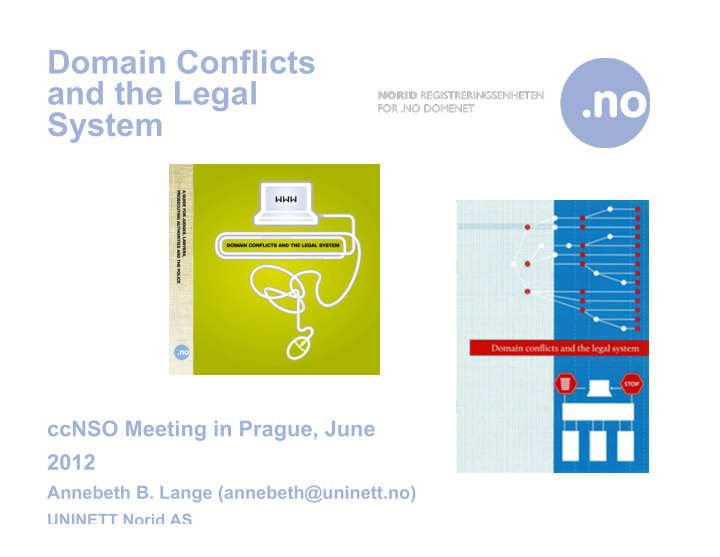



Domain Conflicts and the Legal System ccNSO Meeting in Prague, June 2012 Annebeth B. Lange (annebeth@uninett.no) UNINETT Norid AS
The starting point l Pressure from the police on take down and deletion of domain names l Court case: 2 http://www.norid.no/domenekonflikter/ rettssaker/dommer/hr-2009-01692-beslag- en.pdf - Seizure of domain names legal - Domain name is an object in this context l Cooperation with the police to formalize the process and save time
Our goal - what did we want to achieve? l Explain in few words Internet address system - The system 3 - The inquiries l Inform about the legal framework, organization, roles and responsibilites of l When conflicts arise – what to do l Describe the deletion process
The way forward l Submitted the concept to the police, prosecution authority, court judges, lawyers, academics and government employees for input and dialogue 4 l Very valuable feedback on draft l When finished, distributed to all courts in Norway, to the police, to the lawyers working with IP law, to the lawyers association, to ministries and other public authorities etc l Now in use on the Police Academy for educational purposes
The address system l The domain name system – DNS – phone directory on net – a hiararchic system/»root system» l How to find the services and/or content? l What happens when we enter a domain name in a 5 browser? l http://www.youtube.com/watch?v=42pxnLZJXzo
The legal system 6 Whois- database The Domain Regulation
Domain conflicts l Two types involve domain names - The domain name itself à ADR or Court - The service/content under the domain name • Police or Court 7 l Appeals Selection Committee of the Supreme Court of Norway – Decision 26.8.2009: - “ Norid does not undertake any control of the content of websites; nor does it have any mandate to react to websites that may appear to violate the law; it is up to the police and the judicial system to do this. ”
Domain conflicts - measures l When the domain name itself is involved - The ADR system - And/or the Court l When content or services are involved 8 - Shut down the service is first priority - Can only be done locally - Most efficient to contact the holder or the ISP - Deletion of the domain name through the registry = last resort - We only do that through written statuary authority or by Court order
Deletion of domain names l What really happens? - All email addresses and web pages registered within the domain will cease to function - All name server computers and all other services within the domain will become 9 inaccessible - All sub-domains will become inaccessible l Are you safe if the domain name disappear? l What does not happen? - The service is not so visible - Still there through IP address etc
Deletion of a domain name – an example www samordnaopptak uio cert no nix matnat www 10 holocaust folk Student . vg se com
What can the registry do to help l Produce information l Streamlining processes l Give examples on formulation of injuctions 11 l Participate in debates l Give presentations l And give all asking us for help big smiles (even if we cannot do what they are asking for)
What can be done through Norid’s systems l Voluntary measures requested by the holder only - Update of contact information - Modification of name servers - Domain transfer to new registrar - Suspension of a domain - Transfer to new holder 12 - Deletion l Compulsory measures - Temporary or permanent in both civil and criminal cases - Civil cases – ADR or courts - Criminal cases – Prosecution Authority or Court order • Seizure (suspension) • Confiscation (deletion) l Only then we act – and follow up is important - Both by us – and by the police
More information l http://www.norid.no/publikasjoner/index.en.htm 13 l Or contact me or Peter van Roste if you want to use some of the material to make your own guide
Recommend
More recommend